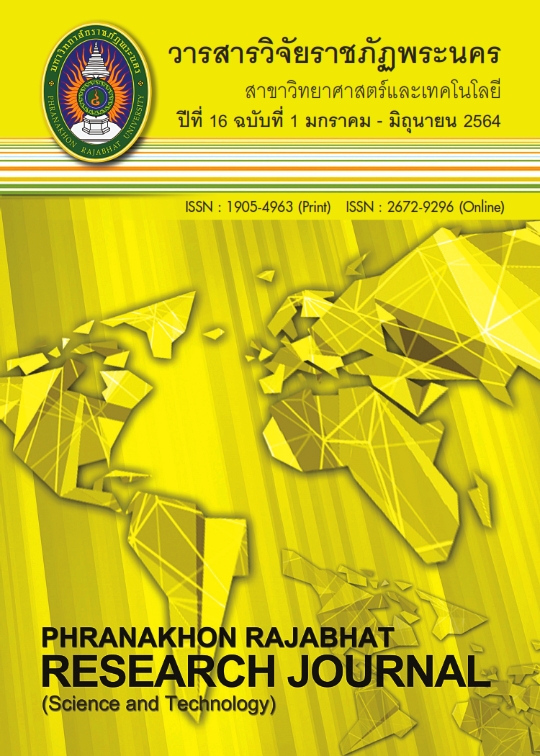DEVELOPMENT OF BLEND MATERAILS BASED ON RICE FLOUR AND GELATIN EXTRACTED FROM NILE TILAPIA (Oreochromis nicoticus) SKIN
Keywords:
blended materials, fish gelatin, rice flourAbstract
This research aimed to study blended materials based on rice flour and gelatin extracted from Nile Tilapia (Oreochromis nicoticus) by extrusion processing. The analysis of the blended materials examined the physical properties, functional group characteristics, mechanical properties,
morphological properties, water uptake measurement, and thermal stability. The results indicated
that after extraction of the Nile Tilapia skin gelatin, the solution was white liquid, translucent, pH
5 – 6, and 2.00% concentration by weight. There were many amino acids in the extracted solution
from the Nile Tilapia skin gelatin. At 4-8 phr of extracted gelatin in the blended materials, the tensile
strength and elongation increased when compared with the rice flour. Furthermore, the mechanical
properties after testing in the saturated relative humidity found that at 10 phr of extracted gelatin
in the blended materials, the value of tensile strength was nearly the rice flour correspond to the
morphological properties from SEM. Otherwise, water absorption increased with the immerse time
and saturation of the water at 4 weeks. The thermal stability results showed that the maximum
degradation temperature tends to increase at 4-8 phr of extracted gelatin in the blended materials.
The evidence of the gelatin extracted from Nile Tilapia could be improved the thermal stability in
the materials.
References
Al-Hassan, A. A., & Norziah, M. H. (2011). Starch-gelatin edible films: Water vapor permeability
and mechanical properties as affected by plasticizers. Food Hydrocolloids, 26(1), 108-117.
Arvanitoyannisa, I., Nakayama, A., & Aiba, S. (1998). Edible films made from hydroxypropyl starch
and gelatin and plasticized by polyols and water. Carbohydrate Polymers, 36(2-3), 105-119.
Dias, A. B., Müller, C.M.O., Larotonda, F.D.S., & Laurindo, J.B. (2010). Biodegradable films based on
rice starch and rice flour. Journal of Cereal Science, 51(2), 213-219.
Giménez, B., Turnay, J., Lizarbe, M. A., Montero, P., & Gómez-Guillén. M. C. (2005). Use of lactic acid
for extraction of fish skin gelatin. Food Hydrocolloids, 19(6), 941-950.
Gómez-Guillén, M. C., Pérez-Mateos, M., Gómez-Estaca, J., López-Caballero, E., Giménez, B., &
Montero, P.(2009). Fish gelatin:a renewable material for developing active biodegradable
films. Trends in Food Science & Technology, 20(1), 3-16.
Jamilah, B., Tan, K. W., Umi Hartina, M. R., & Azizah, A. (2011). Gelatins from three cultured
freshwater fish skins obtained by liming process. Food Hydrocolloids, 25(5), 1256-1260.
Kachenpukdee, N., Siriporn, P., & Jewpraditkul, A. (2006). Production of Gelatin from Scales of White Snapper (Lates calcarifer), 468-480 (in Thai).
Kakkar, P., Madhan, B., & Shanmugam, G. (2014). Extraction and characterization of keratin from bovine
hoof:A potential material for biomedical applications.Springerplus.doi: 10.1186/2193-1801-3-596
Muyonga, J.H., Cole, C.G.B., & Duodu, K.G. (2004). Fourier transform infrared (FTIR) spectroscopic study
of acid soluble collagen and gelatin from skins and bones of young and adult Nile perch (Lates niloticus). Food Chemistry, 86(3), 325-332.
Ottenhof, M.A., & Farhat, I. A. (2004). The effect of gluten on the retrogradation of wheat starch. Journal of Cereal Science, 40(3), 269-274
Pollution Control Department. (2017). Thailand Waste Management Situation Report 2016.
Retrieved, from http://www.oic.go.th/FILEWEB/CABINFOCENTER3/ DRAWER056/GENERAL/
DATA0000/00000689.PDF [2017, 9 June.] (in Thai)
Ran, J., Hu, J., Chen, L., Shen, X., & Tong, H. (2017). Preparation and characterization of gelatin/
hydroxyapatite nanocomposite for bone tissue engineering. Polymer composites, 38(8), 1579-1590.
Rhim, J. W., Wu, Y., Weller, C. L., & Schnepf, M. (1999). Physical Characteristics of a Composite Film of
Soy Protein Isolate and Propyleneglycol Alginate. Journal of Food Science, 64(1), 149-152.
Stortz, T. A., & Marangoni, A. G. (2011). Heat resistant chocolate. Trends in Food Science & Technology,
(5), 201-214.
Tongdeesoontorn, W., Mauer, L. J., Wongruong, S., Sriburi, P., & Rachtanapun, P. (2012). Mechanical
and Physical Properties of Cassava Starch-Gelatin Composite Films. International Journal of Polymeric Materials and Polymeric Biomaterials, 61(10), 778-792
Wanwaja, P., Nu-Yang, P., & Wiriya-amornchai, A. (2019). Influence of Amount of Keratin from Human
Hair with Modified Tapioca Starch. Burapha Science Journal, 24(2), 458-470.
Xu, Y.X., Kim, K.M., Hanna, M.A., & Nag, D. (2005). Chitosan–starch composite film: preparation and
characterization. Industrial Crops and Products, 21(2), 185-192.
Yoksan, R., Sane, A., Watcharaporn, A., & Watcharaporn K. (2017). Bio-based plastic from Thai economic plants. Retrieved, from http://www3.rdi.ku.ac.th/exhibition/52/ 03-foods/
rungrong/ food_00.html. [2017, 9 June.] (in Thai)
Yomyat, S. (2020). What flour is used for baking? Retrieved, from http:// biology.ipst.ac.th/?p=3266
, 24 November.] (in Thai)
Zaher, K., Kolli, E.M., Riahi, F., & Doufnoune, R.(2009). Preparation and Characterization of Hydrocolloid
Biopolymer-Based Films for.International Journal of Polymeric Materials and Polymeric Biomaterials, 58(12), 665-680.
Zhang, N., Liu, H., Yu, L., Liu, X., Zhang, L., Chen, L., & Shanks, R. (2013). Developing gelatin-starch
blends for use as capsule materials. Carbohydrate Polymers, 92(1), 455-461.
Downloads
Published
Issue
Section
License
โปรดกรอกเอกสารและลงนาม "หนังสือรับรองให้ตีพิมพ์บทความในวารสารวิจัยมหาวิทยาลัยราชภัฏพระนคร สาขาวิทยาศาสตร์และเทคโนโลยี" ก่อนการตีพิมพ์




